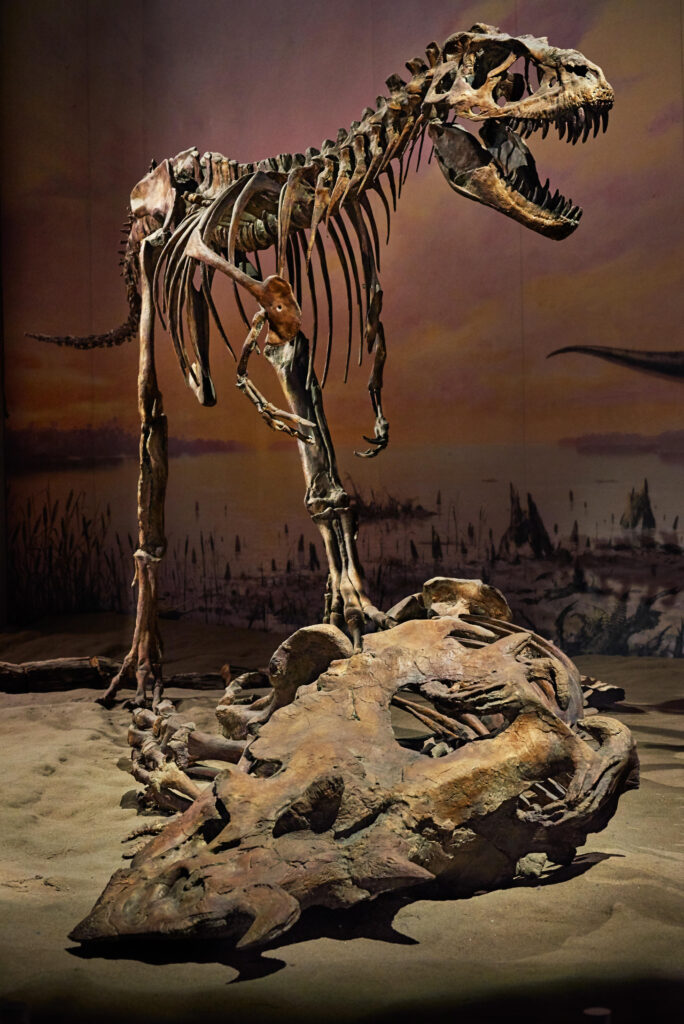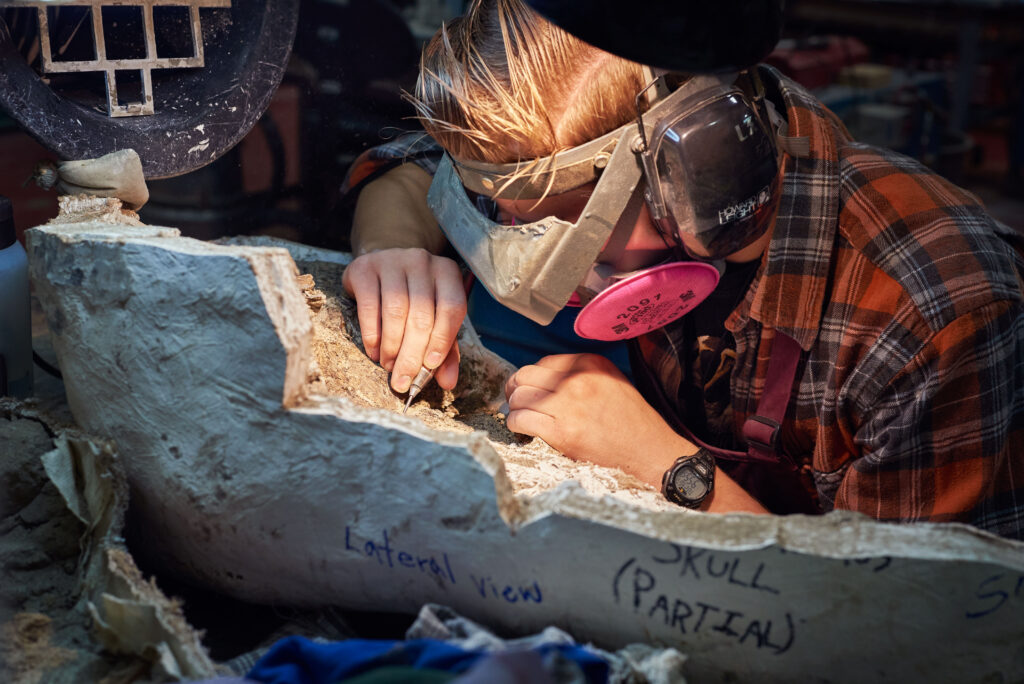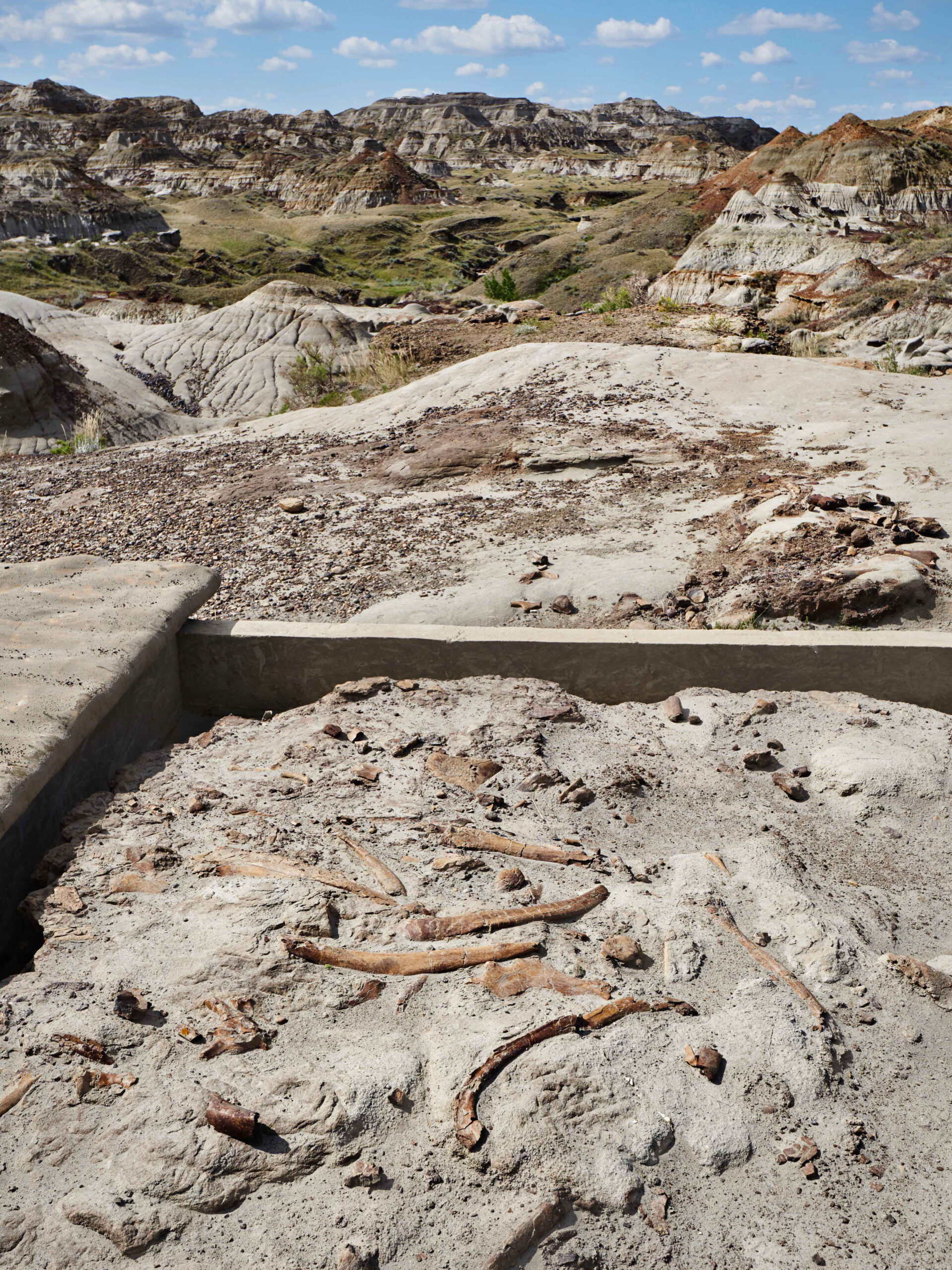‘From the tiny to the terrifying, we have a wealth of species on display’, says palaeontologist Dr Jim Gardner. ‘Unlike natural history museums in big cities like London or New York, most of the world-class dinosaur fossils you see here were discovered right on the doorstep in Alberta.’
I’m on a tour of the Royal Tyrrell Museum, a palaeontology museum and research centre in the small town of Drumheller, a 90-minute drive northeast of Calgary. ‘Alberta has long been an epicentre for dinosaur discoveries’, he explains as we wander through the museum’s many gasp-inducing galleries. ‘That’s because 70 to 80 million years ago it was covered by a semi-tropical coastal plain teeming with life. Seasonal storms and floods killed lots of the animals and then quickly buried them under sediment, so you had the ideal ecosystem to support dinosaur life, and the perfect conditions for preserving their remains when they died.’
Fully reconstructed dinosaur skeletons are visible at every turn: from a long-necked Camarasaurus, the tallest creature ever to have walked the earth, to a vicious-toothed Tyrannosaurus rex, unearthed by chance by schoolboys fishing in the province’s Crowsnest River.
But I’m not here just to admire the skeletons on public display. Dr Gardner has invited me backstage too, for a look at some of the machinations of the museum. We begin in the arrivals bay, where a forklift is just pulling in with its cargo of discoveries fresh from the field; the great bones and body parts wrapped in protective jackets of plaster and burlap. ‘It’s enshrined in law,’ explains Dr Gardner. ‘Anything dinosaur-related that’s discovered in Alberta has to come here first to get checked out.’

Royal Tyrrell Museum © Simon Urwin
We continue to a research lab, where paleontological technicians are busy working away on their various samples of prehistoric life, looking to see if they merit further scientific exploration. ‘Each process is as delicate as cutting a diamond,’ one tells me, while slowly teasing a dinosaur’s head crest from a piece of rock. ‘It’s particularly nerve-wracking because the specimens are so precious. You never know what new scientific discovery you might be holding in your hands.’
Nearby, another technician is intricately piecing together the skull of what appears to be a horn-faced Ceratops. ‘Even after many years, I still have a sense of wonder about the work,’ she says. ‘It’s like being a detective, except the puzzle we are trying to solve is millions of years old.’
We head further into the building and enter a storage space filled with dinosaur fossils that are awaiting shipment to other institutions for further study or public exhibition. There, Dr Gardner moves aside a jumble of wooden crates to reveal one of the museum’s most spectacular pieces – an Ornithomimosaur, or mimic-bird-lizard, which lies in a dramatic death pose. He explains that the black hash marks spotted on its arms were later discovered to be attachment points – offering exciting new evidence that this dinosaur group had feathers.
The Dinosaur Capital of the World
Like many of the museum’s grandest specimens, the Ornithomimosaur was discovered in Dinosaur Provincial Park, a UNESCO World Heritage Site and one of the richest dinosaur fossil locales in the world. It lies a two-hour drive away, across prairie so pancake-flat and featureless, the sky itself is the only scenery on route; one minute scudding with clouds that resemble a fleet of great UFOs,
the next swollen with a towering black anvil, its Biblical thunder and lightning storm providing a suitably dramatic introduction to the park’s startling Badlands topography.

It was at the end of the last ice age, 14,000 years ago, that the landscapes of Dinosaur Provincial Park were formed, as violent torrents of meltwater surged from glaciers over a kilometre thick, cutting downwards through the rock, and exposing some of the fossilised animal bones locked within them.
‘Snake skeletons have been found here,’ explains Lois Schmidt, one of the park’s guides. ‘They date back to the time of the dinosaurs and, incredibly, those same creatures are still around to this day. Our short summers and long winters mean the snakes don’t build up large venom supplies though, so they’ve never killed anyone with a bite – not yet, anyway,’ she adds with a wry smile.
We set out on one of the trails open to tourists, trekking through avenues of mysterious hoodoos, or ‘fairy chimneys’, before cresting a ridge with views across an immense dinosaur-bone bed, which covers an area the size of two football pitches. ‘This is the resting place of a herd of horned Centrosaurus, a relative of Triceratops,’ she tells me. ‘They were around 1,000 strong and, looking at the way the bones lie, it appears they panicked and perished while fording a swollen river.’
A large and important discovery, Schmidt is quick to point out that it nonetheless represents just a small fraction of all that’s been uncovered to date within the park’s borders. More than 500 different ancient life forms have been found here – including around 10% of all known dinosaur species – and more than 300 complete dinosaur skeletons. No wonder they call it the real Jurassic Park.
Later that day, I meet up with aptly named palaeontologist, Amber Whitebone, to take a hike ever deeper into the park’s wilderness. ‘It’s incredible to think that the craze for all things dinosaur might not have happened without the top hat,’ she says, as we set off across a stark, otherworldly plain; its rocks striped in shades of russet, black and grey.

Between the 1820s and 1840s there was a huge demand in Europe for animal pelts, especially beaver, to make top hats. Foreign trappers came to the Red Deer River, which cuts right through here because it had an abundant beaver population. The trappers traded with the area’s original inhabitants, the Blackfoot people, who had been finding fossils long before the first Europeans came. They didn’t recognise them as dinosaurs, though – instead they called them the ‘grandfather of the bison’, their most sacred animal.
‘Word soon spread about the fossils the Blackfoot people had found and, by the 1870s, the age of dinosaur exploration had begun. Come the early 1900s, the ‘Great Canadian Dinosaur Rush’ was on, and the rest is history.’
Our trek reaches an end in the Valley of the Castles, an area of tortured rock formations dramatically carved some 75 million years ago. ‘Just 10 million years later, and the mass extinction of the dinosaurs occurred,’ says Whitebone, while casually pointing to the tibia and fibula of a duck-billed Hadrosaur protruding from the ground. ‘The end of the Age of the Dinosaurs, the Late Cetaceous period, was when the dinosaurs were at their biggest and baddest, and we have the most remains here from that period, more than anywhere else in the world.’
New finds are unearthed all the time, notably after fierce rainstorms when mud and silt is washed away to reveal bones. ‘You never know what you’re going to find. When you spot one and start digging, it might be just a tiny shard or a full skeleton. It’s the palaeontology version of playing the lottery’, she says.
‘Regardless, I still get the same rush from handling this incredible and unique evidence of prehistoric life. By understanding the distant past, we can better understand the present, and even make some predictions about the future, too. And that’s what’s so thrilling – with every discovery, the way we see the world becomes clearer. All thanks to the dinosaurs.’
Simon Urwin is an award-winning photographer and writer who has long sought to showcase hidden stories from across the world. Widely published, his work can be found in BBC Travel, Sidetracked and more